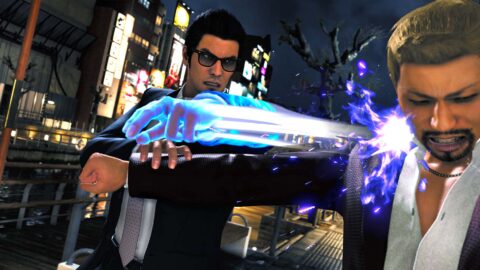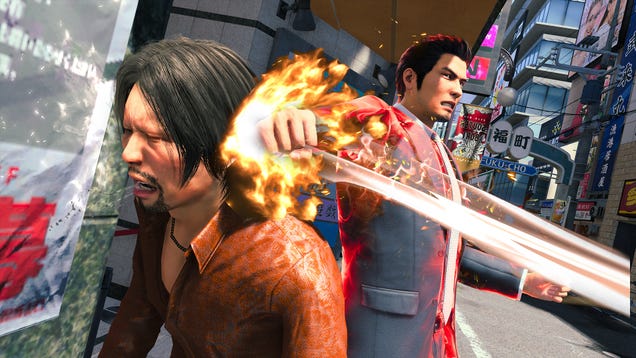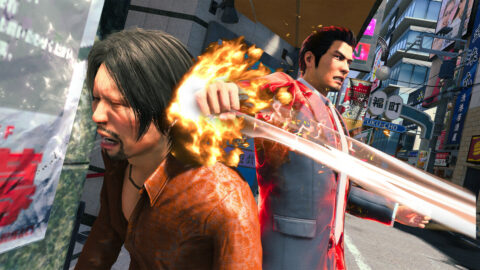In a fast-moving news cycle, a personnel change wouldn’t seem to catch our attention, but this morning dating app Bumble announced a doozy: It’s replacing founder CEO Whitney […]
The race to build tomorrow’s AI models, and signs of life in the crypto markets
Listen here or wherever you get your podcasts. Hello, and welcome back to Equity, the podcast about the business of startups, where we unpack the numbers and nuance behind the […]
Like A Dragon Gaiden: The Kotaku Review
‘Like a Dragon Gaiden’ review: Still fun, but a tiny step backward
‘Like a Dragon Gaiden: The Man Who Erased His Name’ is a fun ‘Yakuza’ throwback that takes a bit too long to hit its stride.

Like a Dragon Gaiden: The Man Who Erased His Name may have new branding, but this is a game about embracing old comforts, more than anything else.
Formerly known as Yakuza in the West (Sega rebranded it to Like a Dragon, a more literal translation of its Japanese name, in the last year), the latest game is a lot like its predecessors. Like, a lot. It takes place in the same neighborhood as three of the previous games. A lot of the same side activities are here. Most importantly, it’s the grand return of longtime series protagonist Kazuma Kiryu.
This is, essentially, a side story — one that’s a lot shorter than most other games in the series (it took me 10 hours to complete the main storyline, whereas other games typically take between 20-50 hours). Like a Dragon Gaiden is about as fun as a game can be while still feeling inessential. Its story takes too long to reach its (excellent) emotional payoff, and the return to brawler-style combat feels a bit like a step backward.
But if you’ve ever liked Yakuza in the past, this bite-sized organized crime saga is still worth the time. The fact that it’s a day one Xbox Game Pass game means you might not even need to pay full price for it, too.
Back to Sotenbori
Warning: This section will feature story spoilers for Yakuza 6 and Yakuza: Like a Dragon
Any series approaching 10 mainline entries is inevitably going to get up to some convoluted timeline shenanigans, and this one is no different. Let me clear things up right away: Like a Dragon Gaiden takes place concurrently with 2020’s Yakuza: Like a Dragon, to date, the most recent game in the series. The whole idea is to explain just what the heck Kiryu got up to after faking his death at the end of Yakuza 6 in order to protect his loved ones.
Surprise! It turns out he spent most of that time beating people up on behalf of the shadowy organization that helped him fake his death and gave him a new name. It doesn’t take long before he gets roped into another semi-complicated yakuza scheme involving crime families, both new and old, ultimately culminating in the climactic dissolution of the Tojo Clan and Omi Alliance, as seen in Yakuza: Like a Dragon.
The plot takes Kiryu to Sotenbori, a neighborhood prominently featured in Yakuza 0, 2, and 5. Recycling an old mini-open-world might be a disappointment in any other series, but it’s just how Yakuza rolls. Playing through these games in order means eventually developing a real relationship with each neighborhood, and as a series vet, it’s always nice to return to Sotenbori, with its gorgeous riverfront, bustling commerce district, and seedy back alleys full of goons to beat the holy hell out of.
As much as we love the current series protagonist and ultimate himbo Kasuga Ichiban, I have to admit there’s some comfort in spending 10 to 20 hours with Kiryu again. He is, simply put, one of the best gaming heroes of all time. Kiryu is a stoic warrior-monk who is equally capable of doing the coolest action guy stuff you’ve ever seen and spitting out some fire philosophical wisdom right afterward.
Like a Dragon Gaiden‘s plot machinations are largely sort of uninteresting until an explosively delightful and wonderfully stupid final act. It’s worth the wait for what is a genuinely heart-wrenching emotional payoff, something fans have been waiting for from Kiryu for years. He finally gets some real, self-serving introspection after decades of fighting on behalf of others.
If you love Kiryu, this game is worth playing for that alone.
Advanced wire-fighting maneuvers

Credit: Sega/Steam
The other vector by which Like a Dragon Gaiden is a throwback is a little bit less endearing to me.
Specifically, developer Ryo Ga Gotoku Studio (RGGS) brought back the franchise’s old real-time brawler combat that fueled fights for the first seven games. To be clear, it’s still fun, and they’ve done a couple of things to freshen it up. Timed parry counters are here for certain unblockable attacks, and Kiryu has a goofy-ass new “Agent” fighting style full of hilarious gadgets to use for big group encounters.
For instance, there’s a “spider wire” that comes out of a watch, which you can eventually upgrade to ensnare around five enemies at once — whipping them around the arena or stealing weapons out of their hands. Drones can be deployed for self-defense, exploding cigarettes can be thrown like grenades, and rocket shoes can be used to violently propel Kiryu into groups of helpless dudes.
It’s still the same arcadey beat-’em-up nonsense the series used to be known for before it switched to more strategic turn-based battles with Yakuza: Like a Dragon, and that would be fine in a vacuum. Unfortunately, the turn-based combat in the newer games is just a lot more dynamic and interesting to me. Boss fights require more tactical planning (in Gaiden, you just punch and dodge until it’s over), and there’s a huge variety of options at your disposal.
By comparison, Like a Dragon Gaiden feels simplistic to its detriment. There is depth to be found in the upgrade system, but unless you feel like pouring hours into side quests to earn the money required for top-tier upgrades, you may never see the best stuff.
I get the rationale for this. RGGS wanted to make a game for the folks who prefer the old style of combat because not everyone vibes with turn-based fights. It’s a smart business decision, and it’s executed well enough here. I just feel that it’s a little hard to go back after the bold and delightful shift a few years ago.
It’s fun to see an old friend

Credit: Sega/Steam
Of course, it wouldn’t be a Yakuza game without a copious amount of side activities to play with. You can golf, play darts, participate in pocket car races, and do karaoke just like in previous games. This may be a comparatively small game, but it’s not lacking in any of the bells and whistles.
There are plenty of juicy side quests to do as well (some featuring characters from previous games or spin-offs), and these are as fun and funny as always. As I said, this is a lot like previous Yakuza games, and that’s not a bad thing! Similar to the last few entries, it also looks great and runs flawlessly on PlayStation 5.
In general, it’s warm and soothing to pal around with Kiryu and co. for another game, especially after his role as the protagonist was snatched away by someone else. I wish its storyline felt more essential, and I do bemoan the return of brawler combat, but there are enough high points to be found in both that I can’t hate either aspect of Like a Dragon Gaiden.
And it accomplished its ultimate goal, which is to get me super excited for the upcoming Like a Dragon: Infinite Wealth in January 2024.
Firefly’s Blue Ghost lander represents a big bet on a future lunar economy
Travel just north of Austin, Texas, and you might find yourself in startling proximity to a lunar lander. That’s Firefly Aerospace’s Blue Ghost lander, a 6.6-foot-tall spacecraft that […]
Confirmed: Palo Alto has acquired Talon Cyber Security, sources say for $625M
Palo Alto Networks has just confirmed one more major piece of security startup M&A out of Israel: it has acquired Talon Cyber Security, a specialist in building enterprise […]
Luxury clothing distributors get into virtual try-on tech; bag $15M Series A on a $100M valuation
Sandy Sholl and Adam Freede are no strangers to the world of fashion. They’ve been at the helm of MadaLuxe Group, a luxury distribution platform for fashion and […]
Apple PDF editor deal: Lifetime license for $70
Save on a lifetime license to PDF Expert at the Mashable Shop through Nov. 9.

TL;DR: Through Nov. 9, score a lifetime license to PDF Expert for Mac and experience the convenience of editing PDFs more easily for only $69.99 (reg. $139.99) — that’s 50% in savings for a limited time.
Looking to keep your small business or side hustle more organized? In a world saturated with software for your business needs, you may find it hard to determine which ones are worth your time and money. Fortunately for you, this PDF Expert is on sale through November 9. An Apple Editor’s Choice winner, it allows you to edit, annotate, organize, and convert all your PDFs in one place for a one-time fee of $69.99, and you’ll get access for life, with no coupon needed.
PDFs continue to be one of the most ideal file formats for business documents; however, editing them isn’t possible — or convenient — with standard Mac software. Instead of jumping through hoops trying to figure out how to edit out a typo, rework an entire section of a document, or fill out a PDF form, this software allows you to edit PDF text, images, links, and outlines quickly and easily. You can even add comments, highlights, or pop-up notes to make and share suggestions with your peers for future use.
Whether you’re working on an iPhone, iPad, or Mac device, PDF Expert offers a series of essential functions that can transform the way you work with documents. Plus, its sophisticated AI-powered software has the ability to recognize text so you can quickly search or copy any important information you need without having to read the entire document. It also enhances splotchy scans by fixing distortions, removing shadows, and improving contrast, saving you both time and the headache of a poorly scanned document.
This holiday season, give the entrepreneur in your life the gift of convenient file editing on Mac and take advantage of the best price online for a lifetime license to PDF Expert, on sale for just $69.99 (reg. $139.99) until November 9 at 11:59 p.m. PT.
Prices subject to change.

Opens in a new window
‘The Curse’ review: Emma Stone, Nathan Fielder, and Benny Safdie are here to break your brains
“The Curse” stars Emma Stone and Nathan Fielder as a couple with an upcoming HGTV show, and Benny Safdie plays their producer.

From the bizarre business schemes of Nathan for You to the mind-melting experiments of The Rehearsal, Nathan Fielder has always had a knack for interrogating the “reality” behind reality television. Now, he teams up with Benny Safide — co-director of nail-biting films like Uncut Gems and Good Time — to continue breaking our brains with the new scripted series, The Curse.
Starring Emma Stone, Fielder, and Safdie, and produced by A24 and Showtime, The Curse defies easy categorization. It’s the perfect storm of wince-worthy comedy, HGTV spoof, and surreal (and possibly supernatural?) drama, with plenty of commentary on everything from race to social media thrown in for good measure. As tough as it can be to watch at times — I dare you to go five minutes without cringing — there’s no doubt that The Curse is one of the funniest, strangest, and most unsettling shows of the year.
What is The Curse about?

Credit: Richard Foreman Jr. / A24 / Paramount+ with Showtime
Stone and Fielder play Whitney and Asher Siegel, a married couple at the center of an upcoming HGTV show awkwardly titled Flipanthropy. (Say it three times fast.) Their goal is to build eco-friendly homes in the city of Española, New Mexico, and “revitalize” the community by bringing in upscale coffee chains and jeans stores. It’s textbook gentrification, but Whitney and Asher want to distance themselves from that label. In Whitney’s perfect world, these new businesses will only employ locals, everyone will buy her passive homes, and she and Asher can subsidize any higher rent Española’s current residents may face. “Everybody’s a winner,” Asher tells a local reporter (Tessa Mentus) when she brings up the dreaded “G word.”
Of course, Asher’s blithe statement couldn’t be farther from the truth. The new businesses are more a front for Flipanthropy than they are new staples in Española, and Whitney’s plan to subsidize rent is just a Band-Aid lazily slapped on America’s much bigger issues. Then there are the passive homes themselves, with their garish mirrored facades that Whitney proudly says, “reflect the community.” If anything, the constant reflection is more of a visual nuisance for Asher and Whitney’s neighbors. It doesn’t help that the deceptive mirrors lead to the deaths of birds who fly smack dab into the walls. When bird corpses are a common occurrence around your house, maybe it’s time to rethink whether it’s as environmentally friendly as you claim it is.
Capturing Whitney and Asher’s so-called service work on camera is their producer Dougie Schechter (Safdie). He’ll try anything to make the show as entertaining as possible, no matter the ethics. Take the very first scene, which sees him pouring water on a woman’s face to create the illusion of a tearful response. It’s just one of many exploitative tricks he’ll use on his subjects in order to shape a new reality for the camera. Whitney and Asher are initially put off by these methods, unable to see that they, too, are exploiting the residents of Española.
One of Dougie’s filming plans leads us to The Curse‘s titular malediction. When he sees a young girl named Nala (Dahabo Ahmed) selling sodas in a parking lot, Dougie tells Asher to give her some money, thinking it’ll make good B-roll for the show. Asher hands her the only cash he has on him — a $100 bill — and immediately tries to take it back once they’ve stopped filming. Nala, understandably upset by this turn of events, proceeds to fix her gaze on Asher and deliver three fateful words: “I curse you.”
From there on out, things are… off with Asher, Whitney, and the production. There’s conflict with potential home buyers, complications with Asher and Whitney’s plans to conceive, and even discord in their marriage. Are all these bumps in the road Nala and the curse’s doing? Or were these problems always there, and did Asher and Whitney only start to notice them with the threat of a curse hanging over their heads? (Notably, the two also argue about whether it’s racist to assume Nala is even capable of cursing them.)
The Curse skewers reality TV with surreal stylings and a tinge of horror.

Credit: Richard Foreman Jr. / A24 / Paramount+ with Showtime
The Curse plays with just how real Nala’s curse is over the course of its 10 episodes. Strange events on the set of Flipanthropy are commonplace, yet they could just as easily be attributed to human error as to magic. However, The Curse doesn’t rule out the supernatural outright. Horror-adjacent imagery appears throughout, from the dead birds to long shots tracking characters’ movements that would be right at home in a slasher. Discussions of troubled pregnancy invoke the subgenre of motherhood horror, and composer John Medeski (working with music producer and frequent Safdie collaborator Daniel Lopatin) crafts a soundscape that wrings unease out of even the most mundane moments.
The ambiguity of the curse plays into the show’s larger fascination with how we engineer and interact with false narratives. Reality TV serves as the prime source of artifice here, with Asher and especially Whitney crafting how their marriage and their work comes across onscreen. If enough people believe the fantasy they’re being sold, does that make it true? And if you spend your relationship living for the camera, how can you tell what’s real or not?
To further hammer home these ideas of warped reality, The Curse makes liberal use of mirror shots and distorted mirror imagery. It pairs these with shots of conversations framed in windows or doorways, or filmed from a great distance, lending the show a voyeuristic quality. What are we truly meant to be seeing?
The Curse‘s main characters will make you cringe and laugh (but mostly cringe).

Credit: Richard Foreman Jr. / A24 / Paramount+ with Showtime
The Curse‘s preoccupation with artifice manifests itself most in Whitney. She cares so much about her self-image that she forces Asher to recreate their cutest moments beat-for-beat for her Instagram followers. Her activism is a facade as well — although she may not be self-aware enough to realize that. She fervently claims to support Española’s residents, including the Pueblo people of New Mexico. However, she frequently uses and tokenizes the Native Americans she meets, like her artist friend Cara Durand (Nizhonniya Luxi Austin). In a show full of moments that make you want to crawl out of your skin, Whitney’s interactions with Cara are among the most horrifying.
Asher is no stranger to fantasy either, with The Curse relishing unpicking his self-imposed ideas of masculinity. Between jokes about penis size and being called Whitney’s “jester” instead of her “king,” Asher goes through the humiliation gauntlet with a brave face that is always seconds from slipping. Then there’s Dougie, whose sleazy producer persona masks a deeper sadness and some wildly unhealthy coping mechanisms.
With these three characters and their conflicting senses of self firmly in place, The Curse simmers with an at-times unbearable awkwardness. Will you feel a combination of embarrassment and disgust toward Whitney, Asher, and Dougie’s actions? Yes. Will you occasionally recognize yourself in them? Horrifyingly, also yes. When broader moments of comedy arise — like the aforementioned penis jokes — they come as a welcome, tension-breaking relief. Yet The Curse refuses to let you get comfortable for long. Often, these laugh-out-loud jokes will resurface down the line in an even more squirm-worthy scene, as if The Curse is wielding your own prior comfort against you.
Emma Stone, Nathan Fielder, and Benny Safdie make for an excellent trio in The Curse.

Credit: Richard Foreman Jr. / A24 / Paramount+ with Showtime
The Curse wouldn’t work half as well as it does without the total commitment of Stone, Fielder, and Safdie, who make for an unlikely (but well-matched) supergroup. Stone has already proven her comedic chops ten times over with films like Easy A and The Favourite, but The Curse may be her funniest turn yet. Whitney’s eco-influencer jargon is gold in Stone’s hands, but she blends it with a discomfiting sense of artificiality completely in sync with the tone Fielder and Safdie have created. It’s pitch-perfect work, and when paired with the release of Poor Things, it helps mark a banner year for Stone.
In a departure from shows like Nathan for You and The Rehearsal, Fielder is not playing a version of himself but rather an entirely new character. Still, you’ll recognize elements of his prior performances in Asher’s awkward deadpan. He’s a total punching bag for the show, with Flipanthropy focus groups wondering why Whitney would even marry him. That disbelief makes it all the funnier — and uncomfortable, naturally — when Asher inevitably loses his cool. Prepare yourself for some angry, desperate rants from Fielder that will leave you speechless, and some especially inspired physical comedy in later episodes.
As Dougie, Safdie is slippery and scummy, the ideal contrast to Whitney’s earnest(ish) idealism. While shooting Flipanthropy, he reads as a dirtbag Machiavellian schemer looking to get the perfect shot — even at the expense of people like Asher. But in his personal life, he’s a flailing mess. Here, Safdie must shoulder some of The Curse‘s most painful revelations, resulting in tragi-comic scenes like a first date gone off the rails.
These three off-the-wall performances combine with The Curse‘s ambitious genre-bending to make for one of 2023’s most original TV series yet. It’s densely layered with bizarro comedy, bold set pieces, and pertinent social criticism. Yes, Asher, Whitney, and Dougie’s convictions may be hollow, but The Curse is filled to the brim with things to say — and some absolutely wild ways to say them.
Dreamfarm, a startup out of Italy’s Food Valley, is setting its sights on the perfect vegan mozzarella
Vegan cheese isn’t usually anything to write home about, in terms of taste and texture. Dreamfarm, a startup based in Parma, in the Food Valley of Italy, is […]










